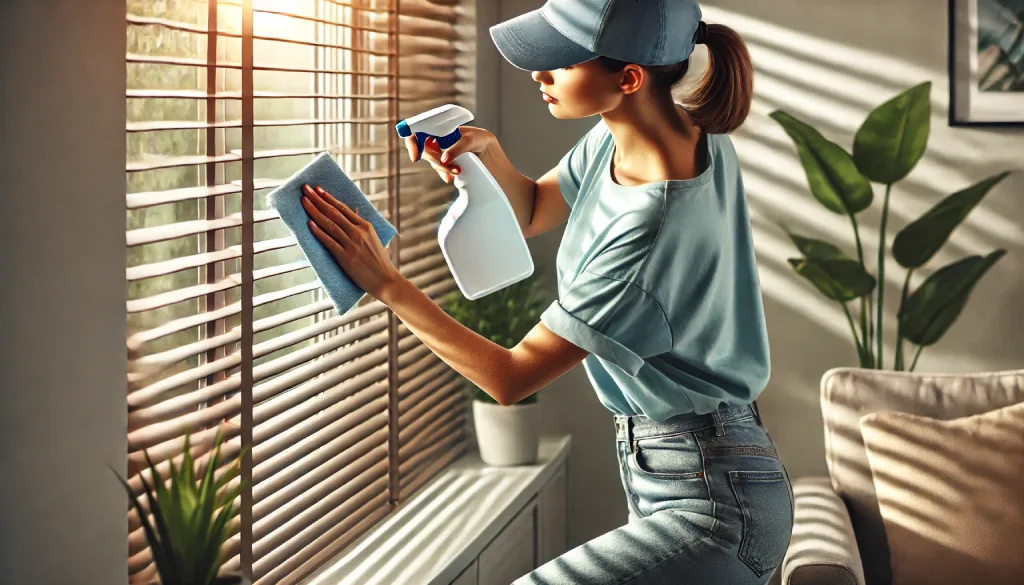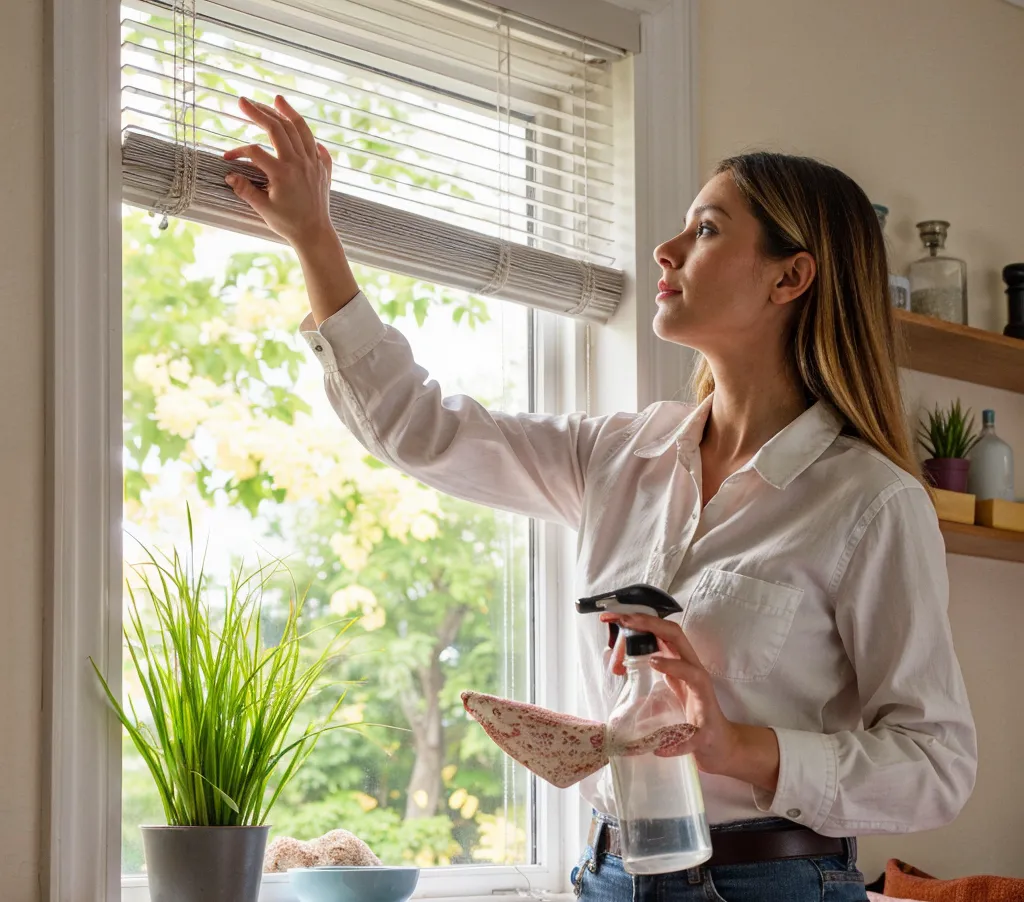Cleaning your blinds is an essential task to maintain a clean and healthy home. Not only do dusty blinds make your home look untidy, but they can also contribute to poor air quality. Neglecting to clean your blinds can lead to the buildup of allergens, dust, and grime, which can negatively affect your health, especially if you suffer from allergies or respiratory issues.
This guide will walk you through the best and easiest ways to clean your blinds, ensuring they look great and function properly for years to come.
Types of Blinds and Their Cleaning Requirements
Blinds come in a variety of materials, and the cleaning method you choose will depend on the type of blinds you have. Some common types include:
- Wooden Blinds: These require gentle cleaning, as excess water can damage the wood. A dry microfiber cloth is usually best, but you can use a slightly dampened cloth if necessary.
- Fabric Blinds: These need to be cleaned carefully to avoid stretching or damaging the fabric. A vacuum cleaner with an upholstery attachment works well for fabric blinds.
- Faux Wood Blinds: These can handle a bit more moisture than wooden blinds but should still be cleaned carefully to avoid warping.
- Metal Blinds (e.g., aluminum): These can typically withstand more moisture, but excessive water may lead to corrosion.
- Vertical Blinds: Vertical blinds often collect dust and grime more quickly, so regular dusting is essential.
Each material has its specific cleaning needs, so be sure to adjust your method accordingly.
How Often Should You Clean Blinds?

The frequency of cleaning your blinds depends on several factors, including your location, climate, and lifestyle. Generally, it’s recommended to clean your blinds once every two weeks. However, if you live in a dusty area or have pets, you may need to clean them more often. To keep your blinds looking their best between cleanings, try wiping them down with a microfiber cloth every few days.
Tools and Materials You’ll Need
Before you start cleaning, gather these essential materials:
- Microfiber cloth
- Vacuum with upholstery attachment
- Screwdriver (for removing blinds)
- Dish soap
- Clean sock (for deep cleaning)
- White vinegar
Optional tools include:
- Compressed air (for getting into small spaces)
- Specialized blind cleaning tools (for deep cleaning or hard-to-reach areas)
Quick Dusting vs. Deep Cleaning
- Quick Dusting: Regular dusting with a microfiber cloth or vacuum attachment is enough for light dust buildup. Dryer sheets can also be used to reduce static and prevent dust from sticking to your blinds.
- Deep Cleaning: For more thorough cleaning, especially for heavily soiled blinds, you may need to remove them and soak them in a bathtub with a cleaning solution.
Step-by-Step Cleaning Instructions

Cleaning Blinds While Hanging
- Close the Blinds: For horizontal blinds, close them and use your microfiber cloth to wipe them carefully from top to bottom. For vertical blinds, wipe them side to side. Hold down the blind with one hand while wiping to ensure it stays in place.
- Open the Blinds: After the first dusting, open the blinds and wipe them again in the opposite direction.
- Use Your Vacuum: Attach the upholstery attachment to your vacuum cleaner and run it over the blinds to remove any remaining dust or debris.
Cleaning Blinds After Taking Them Down
For blinds that are heavily soiled or stained, it’s best to remove them from the window for a deeper clean. Follow these steps:
- Mix Your Cleaning Solution: Combine equal parts of water and white vinegar to create a simple cleaning solution.
- Use a Clean Sock: Dip a clean sock into the solution, squeeze it out slightly, and wipe each blind thoroughly. Make sure every blade is coated with the solution.
- Dry the Blinds: After cleaning, allow the blinds to air dry before rehanging them.
Dos and Don’ts for Different Materials
- Wooden Blinds: Avoid using excessive water, as it can damage the wood. Stick to dry cleaning methods or use a slightly damp cloth.
- Fabric Blinds: Vacuum them regularly to prevent dust buildup. For tough stains, check the manufacturer’s care instructions.
- Metal Blinds: Clean them with a damp cloth and be cautious not to leave water standing on the surface, as this could lead to rust.
Stain Removal Tips
For stubborn stains, try the following:
- Sticky Residues or Grease: Use a specialized cleaner or vinegar solution to remove sticky buildup. A sponge or soft brush can help dislodge the residue.
- Tough Stains: For deep stains, use a mild dish soap solution or consult a specific cleaner for your blind material.
Blind Cleaning Hacks
- Use Dryer Sheets: Wipe your blinds with a dryer sheet to reduce dust buildup and static.
- Repurpose Old Socks or Toothbrushes: Old socks make great tools for cleaning, and toothbrushes can help reach small spaces or stubborn spots.
How to Maintain and Extend the Life of Your Blinds
To keep your blinds in top condition:
- Establish a Cleaning Routine: Clean your blinds every two weeks or as needed, depending on your environment.
- Keep Rooms Dust-Free: Regular vacuuming and dusting of your home will help prevent your blinds from becoming too dusty.
- Avoid Sticky Substances: Keep air fresheners and other sticky products away from your blinds, as these can cause residue buildup.
When to Replace Your Blinds
Even the best-maintained blinds won’t last forever. If you notice any of the following signs, it might be time to replace your blinds:
- Broken slats or cords
- Discoloration or fading
- Difficulty operating the blinds
Professional Cleaning Services

If you find cleaning your blinds to be too time-consuming or challenging, consider hiring a professional cleaning service. Professional cleaners can provide a deep clean, restoring your blinds to their original condition. At Soji, we offer a range of house cleaning services, including blind cleaning, to keep your home in pristine condition. Our team of experts will ensure your blinds receive the care they need, along with every other area of your home.
Conclusion
Keeping your blinds clean is an easy yet effective way to enhance the aesthetics of your home and improve air quality. By following the steps outlined in this guide, you can maintain clean, dust-free blinds that will last for years. Whether you choose to clean your blinds yourself or hire a professional service, it’s important to make regular cleaning a part of your home maintenance routine.
FAQs – Frequently Asked Questions About Cleaning Blinds
Q: Can I use bleach to clean my blinds?
A: It’s not recommended to use bleach on most blinds, especially wood or fabric, as it can cause discoloration or damage. For tougher stains, use a mild cleaning solution with vinegar or dish soap instead.
Q: How do I clean faux wood blinds?
A: Faux wood blinds can be cleaned with a slightly damp microfiber cloth or a vacuum with an upholstery attachment. Avoid soaking them in water, as excessive moisture can damage the material.
Q: Can I wash fabric blinds in the washing machine?
A: It depends on the fabric. Check the manufacturer’s care instructions. If machine washing is not advised, consider using a vacuum cleaner with a fabric attachment or spot cleaning with a mild detergent solution.
Q: What is the best way to clean wooden blinds?
A: Wooden blinds should be cleaned gently with a dry microfiber cloth or a slightly damp cloth. Avoid excessive moisture, as water can warp or damage the wood. You can also use a dusting brush or a vacuum with a brush attachment to remove dust.
Q: How can I prevent dust from building up on my blinds
A: Regular dusting is key. You can use dryer sheets on your blinds to help reduce static and prevent dust from sticking. It’s also helpful to maintain a dust-free environment by vacuuming and cleaning your home regularly.
Q: How do I remove stubborn stains from blinds?
A: For stubborn stains, try using a mild dish soap solution, white vinegar, or a specialty cleaner suitable for your blinds’ material. Gently scrub the stained area with a soft cloth or sponge, and rinse thoroughly.
Q: Are there any special tools for cleaning blinds?
Yes, specialized tools such as a blind duster, vacuum upholstery attachment, or a sock can make cleaning easier. You can also find commercial blind cleaning tools that help clean between the slats.
Q: Can I use a steam cleaner on my blinds?
A: It depends on the material. For fabric or metal blinds, a steam cleaner may be safe, but for wooden or faux wood blinds, avoid using steam as it may cause damage. Always check the manufacturer’s instructions before using a steam cleaner.
Q: How often should I deep clean my blinds?
A: It’s generally recommended to deep clean your blinds once every 1-3 months, depending on how much dust and dirt accumulate. Regular light dusting in between will keep them looking fresh.
Q: What should I do if my blinds are broken or malfunctioning?
A: If your blinds are malfunctioning or have broken slats, it may be time to replace them. If the mechanism or cords are broken, it can often be repaired, but depending on the damage, a replacement may be more cost-effective.

